
English
Caution
1. For your safety…
• Never use the headphones when driving a car, motorcycle, or bicycle. This
could result in an accident.
• Pay special attention to traffic around you when using the headphones
outside. Failure to do so could result in an accident.
• Be careful not to turn up the sound volume too high. Your hearing can be
damaged by listening to sounds at excessive volume for long periods.
• Do not disassemble or modify the headphones.
• Do not allow inflammable, water or metallic objects to enter the
headphones.
• If you find skin problems where the headphones are in contact with the
skin, stop using the headphones; otherwise, it may cause inflammation or
irritation of the skin.
• In the dry air such as in winter, you may feel a static shock when using the
headphones.
2. Avoid using the headphones…
• in places subject to excessive humidity or dust
• in places subject to extremely high (over 40°C or 104°F) or low (under 0°C
or 32°F) temperatures
3. DO NOT leave the headphones…
• exposed to direct sunlight
• near a heater
4. To protect the headphones, DO NOT…
• allow them to get wet
• shake them or drop them against hard objects
❏ Be careful not to apply the power that exceeds the headphones’ input
capacity. This may result in sound distortion and could damage the
oscillation board.
❏ Grasp and pull the plug itself to disconnect the headphones. Do not pull out
the cord.
❏ Do not move or bend the ear cups or any other part of the headphones with
excessive force. It may damage the headphones.
❏ The ear pads will wear out earlier than the other parts even in normal use or
in normal storage due to the characteristics of the material used.
❏ For replacement of the ear pads, consult with the dealer where you purchased
the headphones.
❏ The headphones are designed to have highly airtight structure for
reproducing high quality sound. When putting on the headphones and while
using them, make sure of the followings; otherwise, sudden change of air
pressure in the ear cups may damage your hearing.
– When wearing the headphones, put them on your ears slowly and softly by
sliding it back and forth.
– While wearing the headphones, do not apply any pressure to the ear cups
(do not push them toward your ears).
The headphones are made of wood. Make sure of the followings; otherwise,
the headphones may be broken or the housing may be dented.
– Do not drop the headphones.
– Do not apply an excessive force to the headphones.
If the headphones are broken or damaged due to the above, the repair fee will
be charged even within the warranty period.
Deutsch
Vorsicht
1. Zu Ihrer eigenen Sicherheit...
• Benutzen Sie den Kopfhörer niemals, wenn Sie Auto, Motorrad oder
Fahrrad fahren. Dies könnte zu einem Unfall führen.
• Achten Sie im Freien immer besonders auf den umgebenden
Straßenverkehr. Wenn Sie das unterlassen, besteht die Gefahr von Unfällen.
• Achten Sie darauf, die Lautstärke nicht zu hoch einzustellen. Es besteht die
Gefahr von Gehörschäden beim Hören mit sehr großer Lautstärke über
lange Zeit.
• Unterlassen Sie Zerlegen oder Modifizieren des Kopfhörers.
• Achten Sie darauf, dass keine brennbaren Stoffe, Wasser oder
Metallgegenstände in den Kopfhörer eindringen.
• Falls Hautreizungen durch die Berührung der Kopfhörer mit der Haut
auftreten, beenden Sie die Verwendung der Kopfhörer sofort; andernfalls
können Entzündungen oder andere Hautprobleme verursacht werden.
• Bei trockener Luft, wie etwa im Winter, können Sie bei Verwendung der
Kopfhörer Schläge durch statische Aufladung verspüren.
2. Vermeiden Sie die Benutzung des Kopfhörers...
• an Orten mit hoher Luftfeuchtigkeit oder starkem Staubniederschlag
• an Orten mit sehr hohen (über 40°C) oder sehr niedrigen Temperaturen
(unter 0°C)
3. VERMEIDEN Sie die Einwirkung von...
• direkter Sonneneinstrahlung
• Wärmeeinstrahlung durch einen Heizkörper
4. Zum Schutz der Kopfhörer dürfen Sie diese NICHT...
• nass werden lassen
• stark schütteln oder gegen harte Gegenstände anstoßen
❏ Schließen Sie den Kopfhörer nicht an Geräte an, deren Ausgangsleistung
die Eingangskapazität des Kopfhörers überschreitet. Dies könnte zu
Klangverzerrungen oder Beschädigung der Membran führen.
❏ Ziehen Sie zum Abtrennen des Kopfhörers mit festem Griff am Stecker. Nicht
am Kabel ziehen.
❏ Bewegen oder biegen Sie die Ohrschalen oder andere Teile des Kopfhörers
nicht gewaltsam. Dadurch kann der Kopfhörer beschädigt werden.
❏ Die Ohrpolster verschleißen schneller als andere Teile, auch bei normaler
Ver wendung oder Aufbewahrung. Das liegt an ihren Materialeigenschaften.
❏ Wenn Sie Ersatz-Ohrpolster benötigen, wenden Sie sich bitte an den Händler,
bei dem Sie den Kopfhörer gekauft haben.
❏ Die Kopfhörer wurden so konzipiert, dass sie dicht mit den Ohren
abschließen, um eine hohe Klangqualität zu garantieren. Beachten Sie beim
Aufsetzen der Kopfhörer und während der Verwendung Folgendes, da sonst
plötzliche Druckveränderungen in den Hörmuscheln zu Gehörschäden
führen können.
– Zum Auf- und Absetzen der Kopfhörer, diese stets langsam und vorsichtig
über die Ohren schieben.
– Bei aufgesetzten Kopfhörern keinen Druck auf die Hörmuscheln ausüben
(nicht gegen die Ohren drücken).
Die Kopfhörer bestehen aus Holz. Stellen Sie Folgendes sicher, damit die
Kopfhörer nicht brechen oder die Muscheln beschädigt werden.
– Lassen Sie die Kopfhörer nicht fallen.
– Üben Sie keinen übermäßigen Druck auf die Kopfhörer aus.
Wen n die Kopfhörer aufgrund der oben angegebenen Gründe brechen oder
beschädigt werden, wird Ihnen die Reparatur auch innerhalb der Garantiezeit
in Rechnung gestellt.
Français
Précautions
1. Pour votre sécurité...
• N’utilisez jamais casque en conduisant une voiture, une moto ou une
bicyclette. Cela pourrait provoquer un accident.
• Faites particulièrement attention à ce qu’il se passe autour de vous quand
vous utilisez le casque à l’extérieur. Sinon, cela pourrait entraîner un
accident.
• Faites attention de ne pas régler le volume sonore trop fort. Votre ouïe peut
être endommagée si vous écoutez des sons à un volume excessif pendant
une période prolongée.
• Ne démontez pas et ne modifiez pas le casque.
• Veillez à ce qu’aucun produit inflammable, eau ni objet métallique ne
pénètre à l’intérieur du casque.
• Si vous avez des problèmes de peau quand le casque est en contact avec la
peau, arrêtez d’utiliser le casque; sinon, il pourrait causer un inflammation
ou une irritation de la peau.
• Quand l’air est sec comme en hiver, vous pouvez ressentir un choc statique
lors de l’utilisation du casque.
2. Évitez d’utiliser le casque...
• dans des endroits trop humides ou poussiéreux
• dans des endroits soumis à des températures extrêmement élevées (plus de
40°C) ou faibles (en-dessous de 0°)
3. NE laissez PAS le casque...
• en plein soleil
• près d’un chauffage
4. Pour protéger le casque, NE PAS...
• l’exposer à l’humidité
• le secouer ou le laisser tomber sur des objets durs
❏ Veillez à ne pas alimenter le casque avec un courant dépassant la capacité
d’entrée du casque. Cela pourrait déformer le son et endommager la carte
d’oscillations.
❏ Lorsque vous débranchez le casque, saisissez la fiche du casque. Ne tirez pas
directement sur le cordon.
❏ Ne bougez ni ne tordez pas les oreillettes ou n’importe quelle autre partie du
casque avec une force excessive. Cela pourrait endommager le casque.
❏ Les coussinets d’oreille s’usent plus rapidement que les autres parties du
casque même lors d’une utilisation normale à cause des caractéristiques du
matériau utilisé.
❏ Lorsque vous souhaitez remplacer les coussins d’oreille contactez le
distributeur qui vous a vendu les écouteurs.
❏ Les écouteurs ont été conçus pour présenter une structure étanche à l’air afin
de reproduire un son de grande qualité. Lors du port et de l’utilisation des
écouteurs, veillez à respecter les consignes suivantes, sans quoi le changement
soudain de pression d’air des oreillettes pourrait endommager votre ouïe.
– Mettez doucement les écouteurs sur vos oreilles en les faisant glisser
légèrement d’avant en arrière.
– Lorsque vous portez les écouteurs, n’appliquez aucune pression sur les
oreillettes (ne les poussez pas vers les oreilles).
Les écouteurs sont faits en bois. Assurez-vous de respecter les consignes
suivantes, sans quoi les écouteurs pourraient se casser ou le boîtier être
endommagé.
– Ne faites pas tomber les écouteurs.
– N’appliquez aucune force excessive sur les écouteurs.
Si les écouteurs sont cassés ou endommagés dû à une des raisons
mentionnées ci-dessus, des frais de réparation vous seront facturés, même
sous garantie.
English
About the signals come into the headphones
❏ When playing a digital source (such as CD or DVD), the sound signal comes
in suddenly. Also the sudden blast of sound may caused because the dynamic
range of the headphones is wide. Take care of the volume level on the
amplifier to prevent excessive input of sound signal to the headphones.
❏ Be sure to prevent unwanted noise before performing following operations
by turning down the volume level or turning off the power on the amplifier;
otherwise, the accident such as the burning out of the driver unit’s circuit
may be caused:
– Turning FM stations
– Fast-forwarding a tape
– Turning on or off the other components
– Connecting or disconnecting a microphone
– Replacing the cartridge
– Continuously reproducing high frequency oscillation or high pitch
electronic sounds
Connecting the headphones
❏ After turning down the volume level, connect the plug to the headphone jack
on the target component.
❏ 6.3 mm dia. stereo phone plug is used for the headphones. When the
headphone jack on the target component is 3.5 mm dia. stereo mini jack, use
the supplied conversion cord.
Maintenance
❏ Wipe with a dry, soft cloth if the headphones are stained. If the headphones
are heavily stained, wipe it with a cloth soaked in neutral detergent, then
wipe with a dry cloth. (For the details of using the neutral detergent, follow
its instructions.)
❏ Do not use chemicals such as benzine and thinner for cleaning the
headphones; otherwise, their surface may be deteriorated or the paint may
come off.
❏ The ear pads are expendables. They become deteriorated even in normal use
and storage. For replacement of the deteriorated ear pads, consult with the
dealer where you purchased the headphones.
Specifications
Frequency response 4 Hz – 30,000 Hz
Max. input capability 1,500 mW (IEC)
Nominal impedance 64 ohms
Sensitivity 102 dB/1 mW
Driver unit Ф50 mm
Cord length 3.5 m (11.48 ft) 7N-OFC
Weight 380 g (13.40 oz) (without cord)
Accessory Conversion cord (converts stereo phone plug
to stereo mini plug)
• The wooden housings are made of natural wood. Their appearance may
change if replaced for repair.
• Design and specifications subject to change without notice.
Deutsch
Signalübertragung an die Kopfhörer
❏ Beim Abspielen einer digitalen Klangquelle (z. B. CD oder DVD)
wird plötzlich ein Klangsignal übertragen. Es kann auch eine
plötzliche Klangwelle entstehen, da die Kopfhörer über einen großen
Aussteuerungsbereich verfügen. Die Lautstärke am Verstärker entsprechend
anpassen, damit Klangsignale nicht mit zu großer Lautstärke an die
Kopfhörer übertragen werden.
❏ Vermeiden Sie unerwünschte Geräusche, indem Sie am Verstärker die
Lautstärke reduzieren oder diesen abschalten, bevor Sie die folgenden
Vorg änge ausführen. Andernfalls können u. U. Schäden wie das Ausbrennen
der Treibereinheit entstehen.
– Einstellen von UKW-Sendern
– Schnelles Vorspulen einer Kassette
– Ein- oder Ausschalten anderer Komponenten
– Anschließen und Trennen eines Mikrofons
– Austausch des Tonabnehmers
– Andauernde Wiedergabe von Hochfrequenzschwingungen oder
elektronischen Klangsignalen mit hoher Tonhöhe
Anschließen der Kopfhörer
❏ Nachdem die Lautstärke reduziert wurde, den Stecker in die entsprechende
Kopfhörerbuchse am Zielgerät stecken.
❏ Für die Kopfhörer wird ein 6,3 mm Stereostecker verwendet. Wenn
die Kopfhörerbuchse am Zielgerät eine 3,5 mm Stereo-Minibuchse ist,
verwenden Sie das im Lieferumfang enthaltene Umwandlungskabel.
Pflege und Instandhaltung
❏ Entfernen Sie Flecken von den Kopfhörern mit einem trockenen, weichen
Tuc h. Bei starker Verschmutzung der Kopfhörer, wischen Sie diese mit
einem mit Neutralreiniger getränkten Tuch und danach mit einem trockenen
Tuch ab. (Zur Verwendung des Neutralreinigers, beachten Sie bitte die
Anweisungen auf dessen Verpackung).
❏ Verwenden Sie keine Chemikalien wie Benzol oder Farbverdünner zum
Reinigen der Kopfhörer, da dies die Oberfläche beschädigen und die
Lackierung lösen könnte.
❏ Die Ohrabdeckungen sind dehnbar. Sie können sich auch bei normalem
Gebrauch und ordnungsgemäßer Lagerung abnutzen. Bitte wenden Sie
sich an den Händler, bei dem Sie die Kopfhörer erworben haben, wenn die
abgenutzten Ohrabdeckungen ausgetauscht werden müssen.
Technische Daten
Frequenzgang 4 Hz – 30.000 Hz
Max. Belastbarkeit 1.500 mW (IEC)
Nennimpedanz 64 Ohm
Empfindlichkeit 102 dB/1 mW
Treib ereinheit Ф50 mm
Kabellänge 3,5 m 7N-OFC
Gewicht 380 g (ohne Kabel)
Zubehör Wandlerkabel (Stereo-Klinkenstecker zu
Stereo-Ministecker)
• Die Kopfhörermuscheln bestehen aus echtem Holz. Durch den Austausch
aufgrund einer Reparatur kann sich ihr Aussehen verändern.
• Technische Änderungen vorbehalten.
Français
Signal sonore dans les écouteurs
❏ Lorsque vous écoutez une source numérique (CD ou DVD par exemple),
un signal sonore peut se faire entendre d’une façon soudaine. Celui-ci peut
se produire car la gamme d’amplification des écouteurs est large. Modifiez
le niveau du volume de l’amplificateur pour empêcher tout signal sonore
excessif dans les écouteurs.
❏ Assurez-vous d’empêcher tout bruit indésirable avant de réaliser l’une des
actions suivantes. Pour ce faire, baissez le volume ou mettez l’amplificateur
hors tension, sans quoi un incident pourrait se produire (le circuit du lecteur
pourrait brûler par exemple) :
– Démarrage de stations de radio FM
– Avance rapide d’une cassette
– Mise sous ou hors tension d’autres composants
– Branchement ou débranchement d’un microphone
– Remplacement d’une cartouche
– Reproduction continue d’une oscillation haute fréquence ou de sons
électroniques aigus.
Connexion des écouteurs
❏ Une fois le volume baissé, branchez la fiche de l’écouteur à celle du
composant cible.
❏ Une fiche téléphone stéréo de 6,3 mm de diamètre est utilisée pour brancher
les écouteurs. Si la fiche du composant cible est une mini-fiche stéréo de 3,5
mm de diamètre, utilisez l’adaptateur fourni.
Entretien
❏ Si les écouteurs sont tachés, essuyez-les à l’aide d’un chiffon sec et doux. Si les
écouteurs sont énormément tachés, essuyez-les à l’aide d’un chiffon imbibé
de détergent naturel puis à l’aide d’un chiffon sec. (Suivez les instructions
pour obtenir de plus amples détails sur l’utilisation de détergent naturel).
❏ N’utilisez pas de produits chimiques, tels que de l’essence ou du diluant, pour
nettoyer les écouteurs, sans quoi leur surface pourrait se détériorer ou la
peinture pourrait s’écailler.
❏ Les coussinets s’étirent. Ils s’usent plus rapidement même lors d’une
utilisation normale ou en stock. Pour remplacer les coussinets usagés,
consultez le revendeur chez lequel vous avez acheté vos écouteurs.
Caractéristiques techniques
Réponse en fréquence 4 Hz – 30.000 Hz
Puissance admissible 1.500 mW (IEC)
Impédance nominale 64 ohms
Sensibilité 102 dB/1 mW
Lecteur Ф50 mm
Longueur du cordon 3,5 m 7N-OFC
Poids 380 g (sans cordon)
Accessoire Cordon de conversion (transforme la fiche de
casque standard en minifiche stéréo)
• Les boîtiers en bois sont faits de bois naturel. Ils peuvent changer d’apparence
après réparation.
• Présentation et caractéristiques modifiables sans préavis.


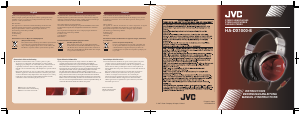

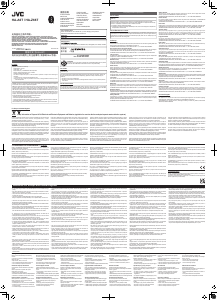
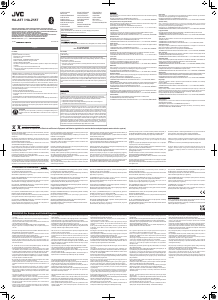
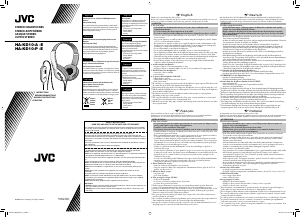

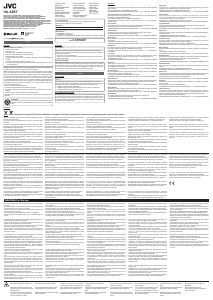
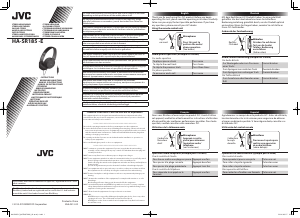
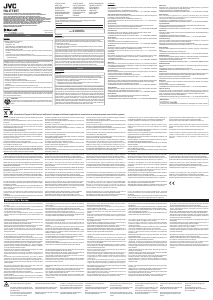
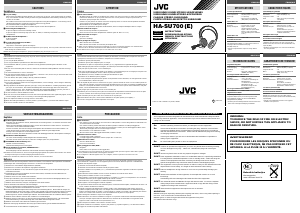
Join the conversation about this product
Here you can share what you think about the JVC HA-DX1000-E Headphone. If you have a question, first carefully read the manual. Requesting a manual can be done by using our contact form.